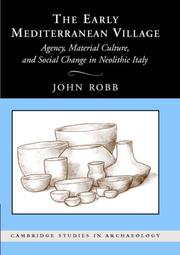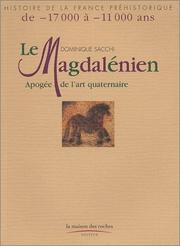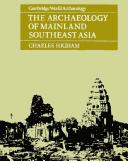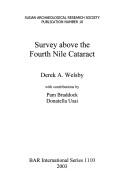| Listing 1 - 10 of 693 | << page >> |
Sort by
|
Book
Year: 2019 Publisher: Santiago, Chile Social-ediciones
Abstract | Keywords | Export | Availability | Bookmark
 Loading...
Loading...Choose an application
- Reference Manager
- EndNote
- RefWorks (Direct export to RefWorks)
The Baño Nuevo 1 cave is a unique and relevant archaeological site for the study of the regional prehistory of Aisén, from thePatagonia and the South American region, particularly for the set of human burials deposited during theEarly Holocene and its long occupational sequence. In this study, the significance of the archaeobotanical record is assessedof Baño Nuevo 1, from a combination of the macro and microscopic lines of evidence, highlighting itscontribution to archaeological information discussing plant supply strategies and their uses amongthe steppe hunter-gatherer groups settled in the place for more than seven thousand five hundred years.Carolina Belmar, Archaeologist specialized in Archeobotany, presents her new book, in which she addresses theUses given to plants by hunter-gatherer groups settled for more than 7,500 years in theBaño Nuevo 1 cave in the Aisén region, Chile. La cueva Baño Nuevo 1 es un sitio arqueológico único y relevante para el estudio de la prehistoria regional de Aisén, de la Patagonia y de la región Sudamericana, particularmente por el conjunto de entierros humanos depositados durante el Holoceno temprano y su larga secuencia ocupacional. En este estudio se valora lo significativo del registro arqueobotánico de Baño Nuevo 1, a partir de una combinación de las líneas de evidencia macro y microscópica, destacando su contribución a la información arqueológica discutiendo las estrategias de aprovisionamiento de las plantas y sus usos entre los grupos cazadores-recolectores esteparios asentados en el lugar a lo largo de más de siete mil quinientos años. Carolina Belmar, Arqueóloga especialista en Arqueobotánica, presenta su nuevo libro, en el que aborda los usos que dieron a las plantas los grupos cazadores-recolectores asentados durante más de 7500 años en la cueva de Baño Nuevo 1 en la región de Aisén, Chile.
Prehistoric archaeology --- Plant ecology --- archeology --- archeobotany --- aisen
Book
Year: 2021 Publisher: Tübingen Tübingen University Press
Abstract | Keywords | Export | Availability | Bookmark
 Loading...
Loading...Choose an application
- Reference Manager
- EndNote
- RefWorks (Direct export to RefWorks)
In recent decades, a significant number of Pleistocene (ca. 2.6 million years–10,000 years ago) open-air and cave sites yielding elephant or mammoth bones in direct association with hominin remains and/or lithic artifacts have been discovered in Eurasia, Africa and America. Many of them show strong evidence of acquisition and processing of proboscidean carcasses by early humans, leading scientists to interpret them as “elephant butchering sites”. Indeed, proboscidean exploitation by early Homo has been proposed to have been critical for Palaeolithic human lifeways, influencing not only their subsistence, but also other aspects of early human evolution and adaptations. The nature and degree of interactions between humans and elephants comprises an important field in palaeoanthropological studies since decades, but many questions remain still unanswered or partially explored. By bringing together research papers from the fields of Palaeolithic Archaeology, Palaeoanthropology, Palaeontology, Zooarchaeology, Geology, Ethnography and Nutrition Studies, the book systematically covers a diverse array of perspectives on elephant-human interactions across the world from the Pleistocene times until today. The volume includes 19 contributions and is organized into four thematic sections: 1) The Palaeolithic record, 2) A view of the evidence, 3) Elephants in past human nutrition, and 4) Ethnography – Human-elephant interactions in recent Africa. Collectively, the volume not only showcases the current state of knowledge, but also intends to provoke renewed interest for current and further research, and build an interdisciplinary and synthetic understanding of the significance of proboscideans throughout human evolution.
Prehistoric archaeology --- Elephants --- Mammoth --- Pleistocene --- Paleanthropology --- Paleontology --- Archaeozoology --- Ethnology
Book
Year: 2019 Publisher: Santiago, Chile Social-ediciones
Abstract | Keywords | Export | Availability | Bookmark
 Loading...
Loading...Choose an application
- Reference Manager
- EndNote
- RefWorks (Direct export to RefWorks)
The Baño Nuevo 1 cave is a unique and relevant archaeological site for the study of the regional prehistory of Aisén, from thePatagonia and the South American region, particularly for the set of human burials deposited during theEarly Holocene and its long occupational sequence. In this study, the significance of the archaeobotanical record is assessedof Baño Nuevo 1, from a combination of the macro and microscopic lines of evidence, highlighting itscontribution to archaeological information discussing plant supply strategies and their uses amongthe steppe hunter-gatherer groups settled in the place for more than seven thousand five hundred years.Carolina Belmar, Archaeologist specialized in Archeobotany, presents her new book, in which she addresses theUses given to plants by hunter-gatherer groups settled for more than 7,500 years in theBaño Nuevo 1 cave in the Aisén region, Chile. La cueva Baño Nuevo 1 es un sitio arqueológico único y relevante para el estudio de la prehistoria regional de Aisén, de la Patagonia y de la región Sudamericana, particularmente por el conjunto de entierros humanos depositados durante el Holoceno temprano y su larga secuencia ocupacional. En este estudio se valora lo significativo del registro arqueobotánico de Baño Nuevo 1, a partir de una combinación de las líneas de evidencia macro y microscópica, destacando su contribución a la información arqueológica discutiendo las estrategias de aprovisionamiento de las plantas y sus usos entre los grupos cazadores-recolectores esteparios asentados en el lugar a lo largo de más de siete mil quinientos años. Carolina Belmar, Arqueóloga especialista en Arqueobotánica, presenta su nuevo libro, en el que aborda los usos que dieron a las plantas los grupos cazadores-recolectores asentados durante más de 7500 años en la cueva de Baño Nuevo 1 en la región de Aisén, Chile.
Prehistoric archaeology --- Plant ecology --- archeology --- archeobotany --- aisen --- archeology --- archeobotany --- aisen

ISBN: 9780521842419 0521842417 9780511499647 9781107661103 9780511342356 0511342357 0511499647 1107661102 110717516X 128108493X 9786611084936 1139130927 0511341822 0511341288 0511340702 Year: 2007 Volume: *3 Publisher: Cambridge : Cambridge University Press,
Abstract | Keywords | Export | Availability | Bookmark
 Loading...
Loading...Choose an application
- Reference Manager
- EndNote
- RefWorks (Direct export to RefWorks)
What was daily life like in Italy between 6000 and 3500 BC? In this book, first published in 2007, John Robb brings together the archaeological evidence on a wide range of aspects of life in Neolithic Italy and surrounding regions (Sicily and Malta). Exploring how the routines of daily life structured social relations and human experience during this period, Robb provides a detailed analysis of how people built houses, buried their dead, made and shared a distinctive cuisine, and made the pots and stone tools that archaeologists find. He also addresses questions of regional variation and long-term change, showing how the sweeping changes at the end of the Neolithic were rooted in and transformed the daily practices of earlier periods. Robb links the agency of daily life and the reproduction of social relations with long-term patterns in European prehistory.
Antiquities, Prehistoric --- Neolithic period --- Prehistoric antiquities --- Prehistoric archaeology --- Prehistory --- Prehistoric peoples --- Italy --- Antiquities. --- Social Sciences --- Archeology
Book
ISBN: 2735108147 9782735108145 2735126382 Year: 2002 Volume: 90 Publisher: Paris : Maison des sciences de l'homme,
Abstract | Keywords | Export | Availability | Bookmark
 Loading...
Loading...Choose an application
- Reference Manager
- EndNote
- RefWorks (Direct export to RefWorks)
Gisement de plein air du Paléolithique moyen du nord de la France, vraisemblablement une halte de chasseurs dont ont été reconnues cinq phases d'occupation qui se sont succédé sur près de 40 000 ans, le site de Bettencourt-Saint-Ouen révèle des données fondamentales pour la connaissance du mode de vie des populations humaines et sur l'évolution de leur environnement au cours de la dernière période glaciaire (de l'interglaciaire de l'Eemien au pléniglaciaire inférieur du Weichsélien). Fait remarquable, la répartition spatiale des vestiges, la technologie et la typologie de l'outillage lithique montrent une pérennité de 112 000 à 68 000 BP des systèmes de production et des traditions culturelles.
Paleolithic period --- Paleolithique --- Bettencourt-Saint-Ouen (France) --- Antiquities. --- Antiquites --- Prehistoric archaeology --- Paléolithique --- Antiquities --- Antiquités

ISBN: 2912691168 Year: 2003 Publisher: La maison des roches,
Abstract | Keywords | Export | Availability | Bookmark
 Loading...
Loading...Choose an application
- Reference Manager
- EndNote
- RefWorks (Direct export to RefWorks)
Magdalenian culture --- Art, Prehistoric --- Magdalénien --- Art préhistorique --- Magdalénien --- Art préhistorique --- Prehistoric Archaeology

ISBN: 0521275253 Year: 1991 Publisher: Cambridge Cambridge university press
Abstract | Keywords | Export | Availability | Bookmark
 Loading...
Loading...Choose an application
- Reference Manager
- EndNote
- RefWorks (Direct export to RefWorks)
Antiquities, Prehistoric --- Prehistoric antiquities --- Prehistoric archaeology --- Prehistory --- Prehistoric peoples --- Southeast Asia --- Antiquities.

ISBN: 1841714887 Year: 2003 Publisher: Oxford Archaeopress
Abstract | Keywords | Export | Availability | Bookmark
 Loading...
Loading...Choose an application
- Reference Manager
- EndNote
- RefWorks (Direct export to RefWorks)
Antiquities, Prehistoric --- Excavations (Archaeology) --- Prehistoric antiquities --- Prehistoric archaeology --- Prehistory --- Prehistoric peoples --- Sudan --- Antiquities.
Book
ISBN: 392755216X Year: 1993 Publisher: Heidelberg : Heidelberger Orientverlag,
Abstract | Keywords | Export | Availability | Bookmark
 Loading...
Loading...Choose an application
- Reference Manager
- EndNote
- RefWorks (Direct export to RefWorks)
Antiquities, Prehistoric --- Prehistoric antiquities --- Prehistoric archaeology --- Prehistory --- Prehistoric peoples --- Egypt --- Antiquities.
Book
ISBN: 9780199556427 0199556423 Year: 2013 Publisher: London Oxford University Press
Abstract | Keywords | Export | Availability | Bookmark
 Loading...
Loading...Choose an application
- Reference Manager
- EndNote
- RefWorks (Direct export to RefWorks)
"Humans occupy a material environment that is constantly changing. Yet in the twentieth century archaeologists studying British prehistory have overlooked this fact in their search for past systems of order and pattern. Artefacts and monuments have been treated as inert materials which were the outcomes of social ideas and processes. As a result materials were variously characterized as stable entities such as artefact categories, styles, or symbols in an attempt to comprehend them. In this book Jones argues that, on the contrary, materials are vital, mutable, and creative, and archaeologists need to attend to the changing character of materials if they are to understand how past people and materials intersected to produce prehistoric societies. Rather than considering materials and societies as given, he argues that we need to understand how these entities are performed. Jones analyses various aspects of materials, including their scale, colour, fragmentation, and assembly, in a wide-ranging discussion which covers the pottery, metalwork, rock art, passage tombs, barrows, causewayed enclosures, and settlements of Neolithic and Early Bronze Age Britain and Ireland."--Jacket.
Antiquities, Prehistoric --- Material culture --- History --- Culture --- Folklore --- Technology --- Prehistoric antiquities --- Prehistoric archaeology --- Prehistory --- Prehistoric peoples
| Listing 1 - 10 of 693 | << page >> |
Sort by
|

 Search
Search Feedback
Feedback About
About Help
Help News
News